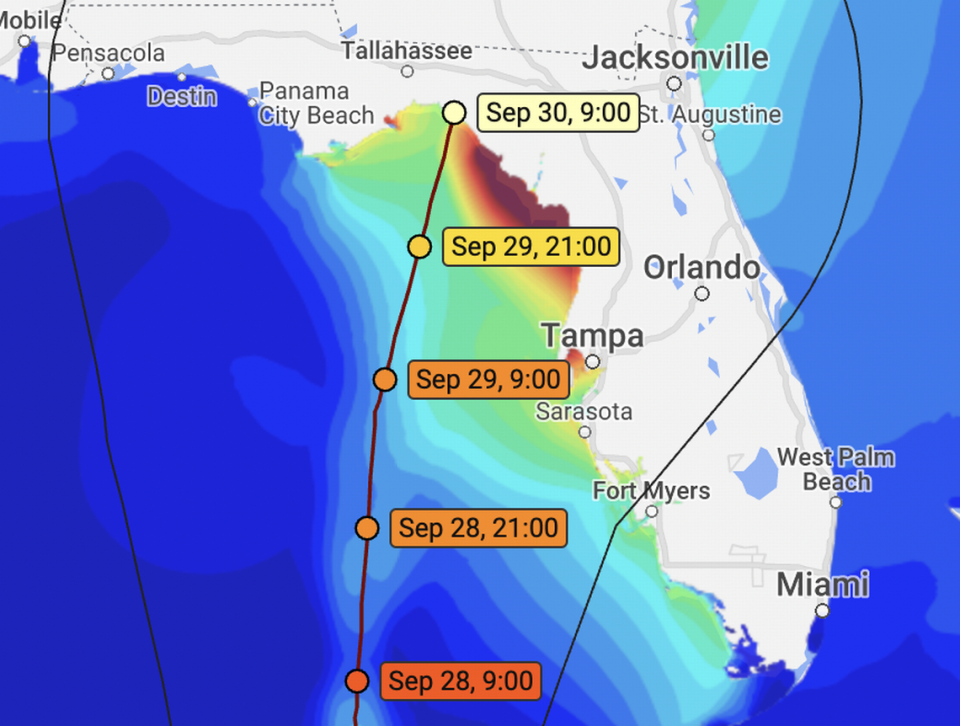What is storm surge? What are its impacts? Is Florida at risk? Your questions answered
As Hurricane Ian snakes toward the Sunshine State over the next few days, officials worry about a potentially dangerous storm surge along Florida’s west coast and panhandle.
Ian became a hurricane Monday morning and could strengthen into a Category 3 hurricane by the time it’s near or over western Cuba Monday night and early Tuesday. Ian will then traverse into the Gulf of Mexico, before heading to Florida.
As it moves around, Ian will leave many regions feeling its wrath, notably through storm surges. Here’s what you need to know about storm surge and its risks to Florida.
What is storm surge?
Storm surge occurs when there’s a departure from normal tide levels, said Pablo Santos, a meteorologist at the National Weather Service in Miami.
“Whatever amount of water you end up with, that is above or beyond the regular tide is storm surge,” Santos said.
A storm’s intensity, its wind field and the topography of the coast all affect the severity of the rise in water, Santos said. Over time, winds push water toward the coast, which causes flooding.
And a slowing storm — like Hurricane Ian — can be a problem.
“A storm that is moving very slowly as it’s approaching the coast, has more time to keep pushing the water further inland as it’s crossing the coast,” he said.
Does storm surge happen when the storm nears the coast?
A storm can generate significant storm surge from afar, Santos said. Especially in areas similar to the Gulf of Mexico, which is almost like an enclosed space.
“You can have the storm moving well offshore... and generating a significant storm surge,” he said.
The shape of Florida’s coast doesn’t help either, he said. With a hurricane moving parallel to the coast, the water ends up getting trapped and amplifies the effects of storm surge.
And with these existing concerns, Santos noted that Ian is also forecast to strengthen into a Category 4 storm over the Gulf.
“Those are prime ingredients... to get a significant amount of storm surge,” he said.
How will Florida be affected by storm surge?
Santos suspects Florida’s west coast will be impacted to varying degrees. Though it’s still too early to tell what areas will be the most affected.
Florida’s west coast is uniquely vulnerable to storm surge. The shallow shelf in the Gulf of Mexico can push tremendous amounts of water onshore.
“Those areas where the coastal topography is very shallow, they’re more prone for surge,” Santos said.
The storm surge that Florida will see varies. Forecasters expect 3 to 5 feet of storm surge will be possible from from East Cape Sable to Card Sound Bridge and 2 to 4 feet in the Florida Keys, including the Dry Tortugas. The most storm surge is expected along Florida’s west coast. Forecasters expect there will be up to 8 feet of storm surge possible from the Anclote River to Englewood, including Tampa Bay and up to 7 feet of storm surge possible from Englewood to Bonita Beach, including Charlotte Harbor.
— National Hurricane Center (@NHC_Atlantic) September 25, 2022
Acting NHC Director Jamie Rhome said the region had “perhaps some of the highest vulnerability in the country” to storm surge.
“I’m telling you it doesn’t take an onshore or a direct hit from a hurricane to pile up the water,” he said. “We could see a significant amount of storm surge on the west coast of Florida even if the storm stays offshore.”

Coastal Emergency Risks Assessment, a map created by Louisiana State University that delivers storm surge guidance, predicts there will be hot spots near Tampa and much of the north-central coast of the state later into the week.
What do I do if there’s storm surge in my area?
If you live in an area that is storm-surge prone, stay informed and follow the advice of local emergency management. You might be ordered to evacuate.
You should know your zone to stay updated if you need to evacuate. You can identify your evacuation zone by inputting your address into this map.
“If you’re living in an evacuation zone and they place you under mandatory evacuation, you should heed that and comply,” Santos said. “Because literally, your life is at risk.”
Miami Herald staff writer Michelle Marchante contributed to this report.

